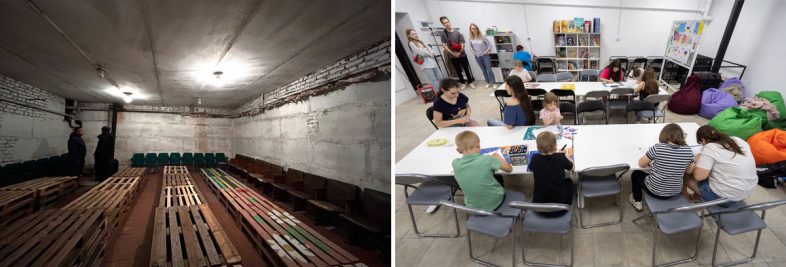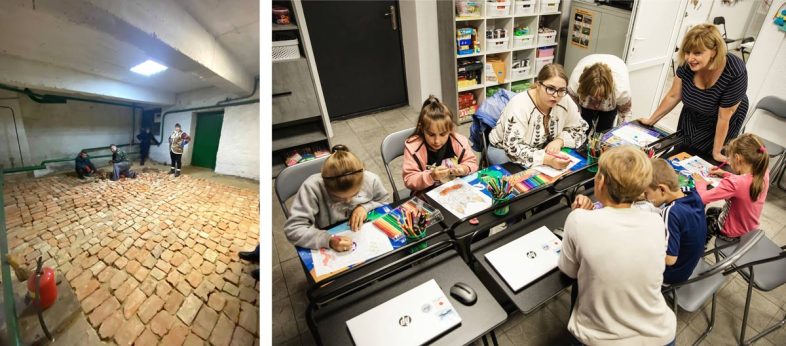With the onset of the full-scale Russian invasion, Ukraine’s education system’s most significant problem is access to it. Russia is intentionally destroying Ukraine’s educational infrastructure, recognising that education is a key factor in shaping the future of the country. As a result, about one in ten schools in Ukraine have been destroyed, with over 1,000 educational institutions left in ruin or damaged beyond repair. Unfortunately, almost 20% of children in Ukraine currently lack the opportunity to attend school in person. This school year, around 2,500 schools, which is nearly 20% of all schools in the country, are only operating remotely.
Research has shown that online learning is less effective than in-person classes, and for many students in Ukraine, this is already their fourth year of studying online. As of February 2023, nearly 1,6 million students were enrolled in online courses, according to the Ministry of Education and Science. However, frequent air raids, power outages, and poor connectivity have affected the quality of education. The lack of educational skills and limited socialisation among students may have a negative impact on Ukraine’s economy in the future. It is essential for Ukrainian society to strive for equal educational opportunities for all children, even during the ongoing war. This is particularly challenging in front-line regions.
On July 7, 2023, the Defence Council of Kharkiv Oblast made a decision to require educational institutions to have specialised shelters for offline learning. Currently, out of 184 institutions, only 126 have the most basic shelters available. Due to the short interval between the announcement of an air raid and Russia’s attacks on Kharkiv, it is impossible to transport the children back to their regular schools.
The mayor proposed establishing a metro school that would be located within the underground metro system. The school officially opened in September of 2023, with classrooms set up at five different metro stations. As of now, there are 75 classrooms available, allowing up to 1,404 students to switch to a hybrid learning format. Under this format, students attend live lessons in person for two to three days a week, while on other days, they engage with the same teachers online.
Buses with police escort transport students to metro school and provide pickup after class. Each class has a team of specialists at the station, including a teacher, tutor, psychologist, and medical staff.
Valeriy Shepel, the deputy director of the education department of the Kharkiv City Council, has explained in a comment to The Ukrainian Week/Tyzhden that the most vulnerable category of students is first graders. Due to the coronavirus pandemic and war, many of these children did not attend kindergarten, leaving them struggling to grasp the material and lacking in prior socialisation. In order to address these challenges, most places in the metro school have been allocated to first graders. This means that 512 children, which is approximately 11% of Kharkiv’s first graders, will benefit from this initiative.
Around 52,000 students in Kharkiv are currently living with their parents, but more families are coming back to the city. Only about 2% of the students go to the metro school. The mayor of Kharkiv, Igor Terekhov, has announced a new project to build underground schools. These schools will operate in two shifts and can accommodate up to 450 students at a time. The construction of the first underground school has already started in the Industrial district. The plan is to finish building it by the new year so that more students can attend in-person classes right from the start of the year. In the future, underground schools will be built in almost every one of the nine districts of Kharkiv.
Similar projects are being implemented in the Kharkiv region. A shelter that will serve as an educational space for 500 students is being built in the town of Korotych. The project complies with all safety standards and, according to the head of the regional administration, Oleh Syniehubov can withstand a direct hit from an S-300 missile.
“It is important to reinstate in-person learning in the areas that are free from conflict. We should explore different alternatives, even if they are temporary. Creating educational spaces in shelters where children can study for a few hours a week is preferable to doing nothing and relying entirely on online learning”, says Hanna Novosad, co-founder of the savED Foundation and Minister of Education and Science of Ukraine in 2019-2020, in a comment to The Ukrainian Week/Tyzhden.
The savED Foundation is working on restoring the educational process in Mykolaiv, Chernihiv, Kharkiv, Kyiv, Dnipropetrovsk, and Zhytomyr regions. The foundation’s team is creating new educational spaces, equipping shelters, rebuilding schools, converting premises for educational purposes, and now also building modular schools.

Multifunctional educational centre at Horodnia Lyceum No. 2, before and after repairs organised by the savED foundation with the support of AWO International and Aktion Deutschland Hilft.
“We operate in 12 settlements located in the Mykolaiv region, all of which are small villages that have lost their schools. Unfortunately, larger educational institutions are always given priority at the state level, leaving children in these small communities without access to education. In order to address this issue, we have partnered with American organisations to develop modular schools for these settlements. This year, we plan to build the first ten of these schools while also retrofitting available premises. We are open to any options provided by the community, including cultural centres and communal facilities”, says Novosad about the foundation’s experience in the Mykolaiv region.
The foundation is working to provide access to education for 180 children in Chervona Dolyna since they are currently without it. To achieve this, they are converting a cultural centre into a school. Another settlement is having a school built in their outpatient clinic. Meanwhile, in Snihurivka, only one of the four schools is still functional, so a large educational space is being constructed in a shelter. This underground school will cover an area of 2000 square meters.
Modular schools are not the same as temporary trailers where construction crews live. The foundation collaborates with the American organisation IREX to create reliable structures for a fully functional educational infrastructure. The first ten modular schools will be built in the Mykolaiv, Kharkiv, and Chernihiv regions. Additionally, they plan to construct a modular school in Bohdanivka, near Kyiv, where there is no educational infrastructure except for the cultural centre that was converted into a school last year. However, the converted centre can only accommodate elementary school children, while the rest have to study at home.
The savED team is currently in the final stage of coordinating the project. They will be selecting specific communities where modular schools will be built. IREX will be responsible for installing the schools, while the savED Foundation will be organising the educational process. The foundation workers will assist institutions in filling gaps in the program, catching up on missed material, creating extracurricular events for children, and implementing support programs for teachers. The foundation is also working on equipping many shelters to be used as large educational spaces. In Mykolaiv, where schooling takes place online due to a high threat of targeted shelling of schools, this is the only opportunity for children to attend live classes for at least a few hours a day.
The presence of shelters itself poses many problems.
“Many cities, including Mykolaiv, are facing a shortage of repairable basement spaces. As a result, new ones need to be dug from scratch. However, the only project that has done this so far was under a school in Borodyanka, which cost a million euros. This is a significant amount of money that the state budget may not be able to cover on its own. Therefore, there needs to be cooperation with international partners to address this issue”, explains Novosad.
In 2023, only one billion hryvnias were allocated from the state budget to establish shelters. This is a relatively small amount considering Ukraine’s current needs. The draft state budget for the next year includes 2,5 billion hryvnias for this purpose, but it has not yet been approved.
Education centres will be established in underground shelters along the border territories of Chernihiv and Kyiv regions. Due to the ongoing conflict in the region, a 20-kilometre training zone has been created where education is only possible in shelters. The level of damage in the Kyiv region is lower due to better air defence, which allows for reconstruction work and the building of schools. Foreign funds, such as those provided by the humanitarian organization Save the Children, have also been helping in these regions. As an example, the shelter at Borodyanka Academic Lyceum No. 1 underwent repairs before the 2023/2024 school year, which will enable in-person learning for all its students.
The situation in the Chernihiv region is quite challenging, especially for small communities that have suffered from destruction. Unfortunately, there is insufficient budget funding available for their reconstruction. However, the savED Foundation has taken on the project ‘Back to School’ to raise 18,3 million hryvnias to equip shelters in schools in this particular region.
“I would like to mention the concept of charter schools, which are quite popular in the United States and could prove beneficial in Ukraine. Charter schools are public schools that are not managed by local authorities but rather by community organizations, universities, or charitable foundations. This allows for more flexibility and innovation in the management of these schools. When Hurricane Katrina struck the United States, most schools were converted into charter schools, which helped them to be quickly restored. This change led to a significant improvement in the quality of education institution management”, explains Hanna Novosad.

Multifunctional educational centre at Anysiv Ivan Franko Lyceum, before and after repairs made by the savED foundation with the support of AWO International and Aktion Deutschland Hilft. Photo: AWO International / Andriy Larin
Given the number of schools that have been destroyed in Ukraine, the following idea is quite relevant. This experience could prove to be especially beneficial in the future for areas that have been liberated after long periods of occupation. It’s likely that the educational infrastructure in these areas has been destroyed, and as a result, the educational process has been disrupted or distorted. In addition to rebuilding the infrastructure, it is imperative that we analyse the educational losses, adapt programs, and build communities from scratch. It is not enough to simply rebuild a school and pick up from where we left off before the destruction. Having a robust civil society capable of taking on responsibilities and effectively managing educational institutions would be invaluable. Therefore, international experience could play a crucial role in achieving this goal.
The material was published in a joint special project of The Ukrainian Week / Tyzhden and the School of Journalism and Communication at the Ukrainian Catholic University.

